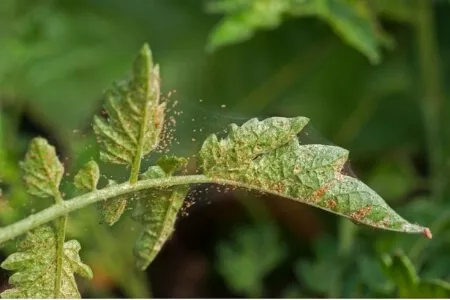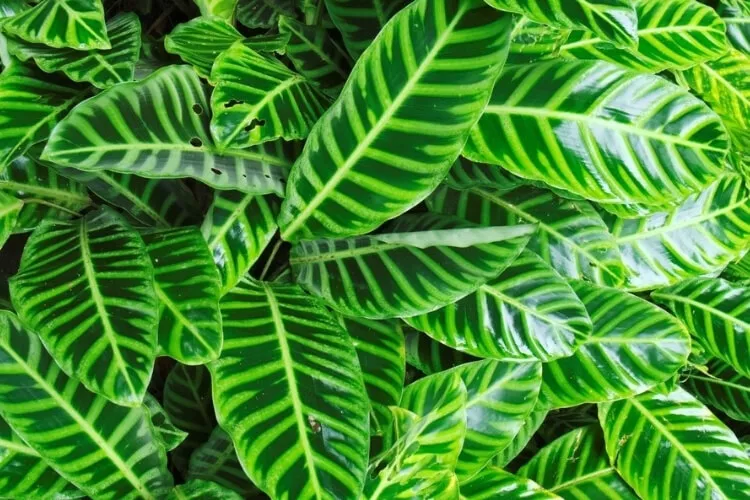The Lemon Lime Maranta is a less-fussy version of the red-veined prayer plant, and to some eyes is even more attractive.
These intriguing plants have vibrant coloring and are well-adapted to indoor life as a houseplant. They are also photosensitive, and each striped leaf will close in response to darkness like a pair of hands clasped in prayer.
Read on for more on where this gorgeous plant comes from and how to care for it!
Table of Contents
Lemon Lime Maranta Background
Maranta leuconeura is native to the tropical forests of Brazil. It grows there as a low ground cover beneath trees, and has strong rhizomatous roots that allow it to spread easily from central clumps.
As a houseplant, they have a graceful trailing habit that makes them ideal for high shelves or tall plant stands.
The genus Maranta (also known as Marantaceae) is named after the 16th-century Italian botanist, physician, and literary critic Bartolomeo Maranta.
The specific botanical name leuconeura means “white string” or “white vein,” and the leaves of the wild variety do indeed feature white veining.
Selective breeding in greenhouses produced other cultivars that have red veins or less prominent white veins with dappled leaves.

Each individual prayer plant can grow up to fifteen feet out from its central clump, with leaves that are usually five inches long.
The wild variety of maranta will also produce small but pretty white flowers. Marantas grown indoors, however, rarely flower.
Prayer plants are able to sense the difference between darkness and light, and when the sun goes down they fold their leaves. This is called “nyctinasty.”
Researchers still aren’t sure why the plants do this, but it may:
- Slow down evaporative water loss from the leaves’ cells
- Give the plant a lower profile against predators
- Help with temperature regulation
The maranta lemon lime is unique among prayer plants for its bright coloration.
It still has the characteristic white veins, but its vivid markings are yellow-green and bright green–the eponymous lemon and lime. Given that each leaf is almost as large as your hand, it’s pretty darn attention-grabbing!
Where to Buy Lemon Lime Maranta
This plant is a bit unusual, but luckily not so unusual that it’s hard to find. You can find some beautiful plants here on Etsy. A few specific Etsy shops we recommend are:
You may also be able to track down one of these beauties at a garden center or big-box store.
Lemon Lime Maranta Care
Now we move on to the practical side: lemon lime maranta care.
Appropriate pot size and type
Base the size of your pot on the size of your individual plant.
Prayer plants do well in shallower pots or dishes, but the diameter of the pot should be slightly wider than the root ball.
Choose a pot that has plenty of drainage holes, and make sure you have some kind of plant saucer to catch any runoff!
This pot from POTEY has a simple, shallow design and also includes a detached saucer:
Soil
You can use any good potting soil for marantas, but cutting it with some vermiculite or perlite will help make the soil lighter and less likely to get compacted.
Marantas in particular like their soil well-aerated, so don’t pack the soil down tightly around its roots.
Light
Due to their heritage as a ground cover in the tropics, prayer plants prefer bright filtered sunlight.
Direct light will burn their leaves, and dim light will stress them out. They’ll be happy a few feet back from an east-facing window.
Water & Humidity
Like many houseplants that hail from the tropics, prayer plants like things to be damp and humid, as they absorb the moisture in the air through the surface of their leaves.
If there is not adequate humidity, the leaves of your maranta will develop brown, crumbly edges, like this:

Help your prayer plant stay hydrated by keeping its soil moist but not soaking wet.
Raise the humidity around the plant by:
- Missing it every few days
- Grouping it with other plants
- Keeping its pot on a tray of dramp pebbles
If you have appropriate light in your kitchen or bathroom, this plant will love living in these higher-humidity rooms. And if all else fails, use a plant humidifier to help create that tropical atmosphere the maranta loves.
RELATED: For more details and get some ideas, visit our post on how to boost humidity for houseplants.
Keep your lemon lime prayer plant away from heating or cooling registers, as the air that comes out of these is very drying. If necessary, you can put an air deflector over your vent to direct this air away from your plants.
Ambient temperature
The prayer plant likes warm temperatures in the 70 and 80 degrees Fahrenheit range, although it can withstand a cool period in the 60 degrees.
Fertilizing
In spring and summer, feed every two to three weeks with a liquid houseplant fertilizer. In fall and winter, feed every four to five weeks.
This liquid formula from Espoma is easy to mix and has a balanced nutrient content for strong growth.
Over-fertilizing will burn the edges on your lemon lime prayer plant’s leaves, so if this happens to you water thoroughly to flush out as much fertilizer as you can.
Skip application for a few weeks, then resume fertilizing with a more diluted product.
Dormancy
A prayer plant will have a short period of dormancy in the winter when temperatures cool off, so don’t be alarmed if you haven’t seen any new growth for a while!
Your prayer plant will wait to push out new growth when things start to get warmer and lighter in late spring and summer.
Re-Potting
Marantas prefer soil that is well-aerated, with a lot of open space that oxygen and water can move through.
Re-potting annually in spring will ensure that the soil in its pot stays loose and doesn’t have a chance to get compacted. Replacing the soil will also supply the plant with fresh nutrients and remove any salt buildup from the old soil.
If your prayer plant has roots sticking out from the drainage holes or is constantly wanting water no matter how often you give it, these are also signs that you should re-pot into a slightly bigger pot.
There are a few simple steps to re-potting your prayer plant properly:
Step 1. Water your plant thoroughly a few days before you plan to re-pot it, and then just before you do so. This will help the soil slide out of the pot more easily.
Step 2. Clean all of the tools you plan to use and wash your hands well.
Step 3. Give the pot several firm taps on all sides to loosen the soil from the pot. Lay it on its side and wiggle the plant and soil out.
You can use a pencil to poke it up from the bottom through the drain holes, but do not pull on the stems!
Step 4. Inspect your roots and use your sanitize scissors to cut off any very aggressive roots, or any that are dead or drying (brown in color, mushy to the touch).
But try not to remove more than a quarter of your prayer plant’s roots at one time.
Step 5. Place enough new damp potting soil at the bottom of your container to bring the top of your plant’s root ball within 1 or 2 inches of the lip of the pot.
Center the plant in the pot and add soil around its sides, tamping it down very lightly as you go–remember that the prayer plant does best with light, well-aerated soil.
Once you’ve filled the pot, tap it gently but firmly against your work surface to help the soil settle.
Step 6. Wait at least two or three days to water after re-potting.
This dry time will allow the snipped roots to close off any wounds, and will prompt the other roots to begin spreading out in search of water.
Check on your prayer plant in a week or so to see if you need to add any more soil to it.
Leaf Discoloration Problems
When the leaves of your lemon lime maranta appear pale and have a slight curl, this is a sign that they’re getting too much light.
They like their sunlight to be strong, but indirect. Try moving them back from the window or placing them in the filtered shade of a taller houseplant.
Over-watering also causes leaves to go yellow and droop. Let the plant dry out, and then give it more time in between waterings.
If your plant’s leaves starts to develop brown, crunchy edges, remember that proper humidity helps keep the leaves supple and well-colored.
Certain insects cause other discolorations; more on that below.
Plant Diseases
Maranta can come down with a case of leaf spot, which is a fungus. Fungal spots can look like this:

Trim off any affected plants, and apply neem oil as a preventative measure. Adjust your misting and watering schedule for a period of time to allow the plant to dry out slightly.
Insect Attacks
Root mealybugs will hatch amongst the plant’s roots and feed off of them, making the plant look floppy and weak no matter how much you water or fertilize it.
These tiny pests are only about 1/16 of an inch to 1/8 of an inch in length, making them less than half the size of the common above-ground mealybug.
To treat, remove your plant from its pot and gently comb through the roots to remove the bugs. You can also gently rinse the root ball in a bucket of warm water.
Re-pot your prayer plant with fresh soil, and quarantine it from your other plants until it has recovered.
Spider mites are also an occasional problem. They make the leaves become dry and pale, and leave cobweb-like deposits on the bottom of the leaves and center growth point of the plant.
Their webs often look like this:

Cut off any parts that are too far gone, and clean the rest of it thoroughly either with a damp cloth or by rinsing it in the shower or tub.
Spider mites like dry conditions, so mist your prayer plant every day to raise its local humidity. And again, take it to a place removed from your other plants so that the infestation does not spread.
Scale insects don’t look like insects at all, but rather brown, gray, or black lumps on the stem or leaf underside.
This is what scale insects look like on a tree trunk:

Scale insects attach themselves permanently to the plant by the mouth and literally suck its juices, causing stems and leaves to become yellow and weak. They excrete a sticky substance called honeydew.
If you find scale on your lemon lime prayer plant, take it aside from the rest of your houseplants and use a soft cloth and soapy water to clean off each leaf and stem.
Then spray with insecticidal soap or apply horticultural oil. Place it in a shady spot–too much light will make the soap or oil burn the leaves–repeat after ten days, and clean off any dead scale insects.
How to Propagate Lemon Lime Maranta
To propagate your lemon lime maranta, follow the same exact process in our other article where we do a Philodendron Splendid stem cutting.
Or you can cut the root ball in half and pot up each half. However, this second method will shock the plant, and it will need a few weeks to recover completely from it.
Frequently Asked Questions about Lemon Lime Maranta
Final Thoughts
With vibrant neon coloring, an easy-going nature and beautiful trailing growth, the Lemon Lime Maranta instantly cheers up any room of your home.
Follow the care guidelines you’ve learned here, and enjoy your new tropical beauty!
If you found this post helpful, please share it on social media!

